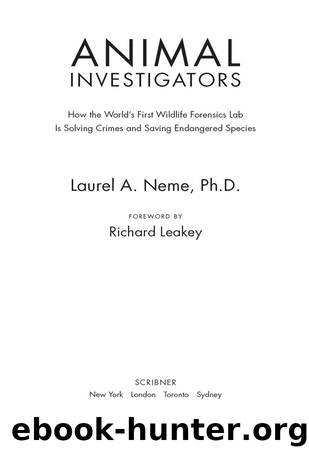Animal Investigators by Laurel A. Neme

Author:Laurel A. Neme
Language: eng
Format: epub
Publisher: Scribner
Published: 2009-09-15T16:00:00+00:00
Espinoza grimaced and called up the Criminalistics Examination Report for Harrison’s case on his computer. He typed in the date—September 24, 1990—and keyed in the particulars for this case. In the main section, he summarized his conclusions: “All bile samples extracted from the evidence gallbladders did not contain the bile salt Ursodeoxycholyl taurine [UDC] which is consistent with belonging to the Ursus genus. Therefore, all the 182 gallbladders analyzed are not bear gallbladders.”15
Harrison wouldn’t like the conclusion but Espinoza wasn’t concerned. He couldn’t change the results, nor would he want to. They were what they were. As a scientist, Espinoza focused solely on analyzing the evidence.
Like everyone at the lab, he remained indifferent to the outcome. The scientists’ disinterest translated into a purposeful lack of awareness of the legal results of their cases. Unless called to testify, they rarely followed a case or even knew what happened with a suspect.
Forensic science has no agenda. It can just as easily prove someone innocent as guilty. As lab director Ken Goddard explained, “We don’t want the scientist to get emotionally involved. We’re not advocates. We don’t try to help the prosecution. We simply answer investigative questions.”16
By design, the lab fastidiously maintains its objectivity. Its scientists receive only the agent’s request for examination of evidence, which describes the item and the type of analysis needed, such as species identification. The examiners don’t see the investigative reports. They don’t know the name of the suspect or the circumstances of the case. Without those details, they can’t make assumptions about what their results mean even if they want to, which they don’t. They can only assess what the evidence actually shows.
The credibility of the lab’s analysis comes from its neutrality. Both sides, the defense and the prosecution, trust it because of the lab’s deserved reputation for remaining unbiased. This impartiality makes the science so powerful that in nine out of ten cases the defense’s legal team has decided not to challenge the lab’s results. Indeed, from fiscal years 2003 through 2005, the lab testified in only 2.4 percent of its cases.17 Most of the time, suspects pleaded out.
While that didn’t happen in this case, the determination that Weston’s gallbladders were not from bear and that he was not culpable simply underscored the lab’s evenhandedness—and that deepened all-around confidence in its results.
Espinoza picked up the phone and told Harrison the results. The agent listened with surprise and dismay. Without forensic proof that Weston sold bear gallbladders, they had little against him. Selling gallbladders from other animals was perfectly legal. With little choice, the assistant U.S. attorney in Denver dropped the remaining wire- and mail-fraud charges against Weston so that, in the end, the dealer went free.
Weston’s case illustrates how the prosecution of animal parts traffickers depends on the lab’s ability to identify the origin of the product sold as a protected species. It doesn’t matter if the dealer is duped. Without proof that the item came from a species whose trade is legally restricted or banned, prosecutors have nothing.
Download
This site does not store any files on its server. We only index and link to content provided by other sites. Please contact the content providers to delete copyright contents if any and email us, we'll remove relevant links or contents immediately.
The Lonely City by Olivia Laing(4575)
Animal Frequency by Melissa Alvarez(4159)
All Creatures Great and Small by James Herriot(3993)
Walking by Henry David Thoreau(3688)
Exit West by Mohsin Hamid(3643)
Origin Story: A Big History of Everything by David Christian(3477)
COSMOS by Carl Sagan(3356)
How to Read Water: Clues and Patterns from Puddles to the Sea (Natural Navigation) by Tristan Gooley(3247)
Hedgerow by John Wright(3114)
How to Do Nothing by Jenny Odell(3106)
The Inner Life of Animals by Peter Wohlleben(3104)
How to Read Nature by Tristan Gooley(3086)
Project Animal Farm: An Accidental Journey into the Secret World of Farming and the Truth About Our Food by Sonia Faruqi(3027)
Origin Story by David Christian(3000)
Water by Ian Miller(2963)
A Forest Journey by John Perlin(2923)
The Plant Messiah by Carlos Magdalena(2754)
A Wilder Time by William E. Glassley(2697)
Forests: A Very Short Introduction by Jaboury Ghazoul(2675)
